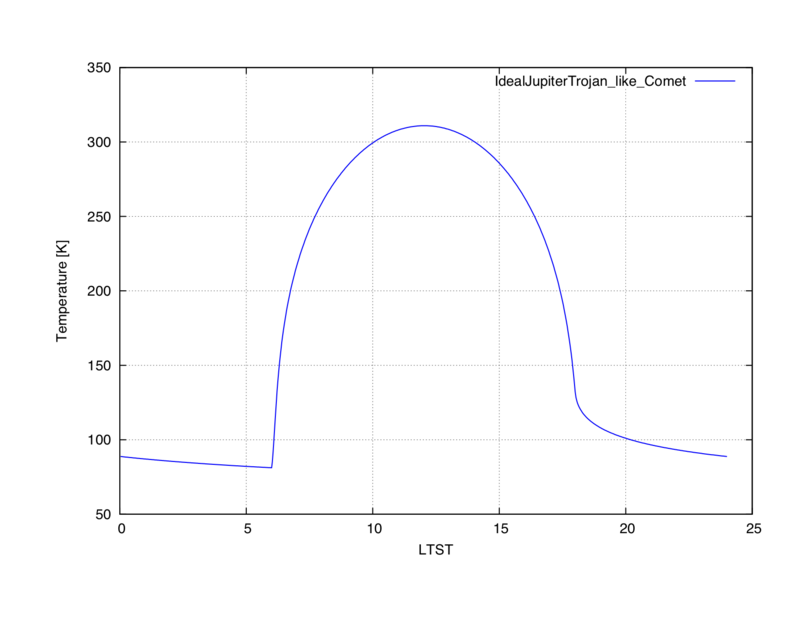KRC for Comets
From krc
(Difference between revisions)
| Line 11: | Line 11: | ||
For other bodies -not in the list above-, the user needs to generate the rotational matrix. First, run PORB to create a structure that can be ingested to generate the orbital rotation matrix. The following arguments are needed: | For other bodies -not in the list above-, the user needs to generate the rotational matrix. First, run PORB to create a structure that can be ingested to generate the orbital rotation matrix. The following arguments are needed: | ||
| − | :e: Eccentricity (Default=0) | + | :'''e''': Eccentricity (Default=0) |
| − | :a: Semi-Major Axis in AU (Default=1) | + | :'''a''': Semi-Major Axis in AU (Default=1) |
| − | :i: Inclination of mean orbit to ecliptic in degrees (Default=0) | + | :'''i''': Inclination of mean orbit to ecliptic in degrees (Default=0) |
| − | :node: Longitude of the ascending node in degrees (Default=0) | + | :'''node''': Longitude of the ascending node in degrees (Default=0) |
| − | :per: Argument of perihelion in degrees (Default=0) | + | :'''per''': Argument of perihelion in degrees (Default=0) |
| − | :m: Mean Anomaly at epoch in degrees (Default=0) | + | :'''m''': Mean Anomaly at epoch in degrees (Default=0) |
| − | :rot_per: siderial rotation period in hours (Default=23.9345) | + | :'''rot_per''': siderial rotation period in hours (Default=23.9345) |
| − | :polera: Right Ascension of the pole in degrees (Default=0) | + | :'''polera''': Right Ascension of the pole in degrees (Default=0) |
| − | :merid: Prime meridian at epoch in degrees (Default=0) | + | :'''merid''': Prime meridian at epoch in degrees (Default=0) |
| − | :poledec: Declination of the pole in degrees (Default=0) | + | :'''poledec''': Declination of the pole in degrees (Default=0) |
| − | :period: Sideral orbital period in Earth days (Default=365.256) | + | :'''period''': Sideral orbital period in Earth days (Default=365.256) |
| − | :name: Body name (default ="None") | + | :'''name''': Body name (default ="None") |
Revision as of 14:31, 10 April 2020
Careful!!! For most comets, the rotation period is not known sufficiently well to be reported. In this case, KRC uses a rotation period of 24h by default.
If the rotation period is known by the user, set it with PERIOD.
For example:
out = krc(lat=0.,INERTIA=50.,T_user=220.,LKofT="T",body="Halley",ls=0.)
For other bodies -not in the list above-, the user needs to generate the rotational matrix. First, run PORB to create a structure that can be ingested to generate the orbital rotation matrix. The following arguments are needed:
- e: Eccentricity (Default=0)
- a: Semi-Major Axis in AU (Default=1)
- i: Inclination of mean orbit to ecliptic in degrees (Default=0)
- node: Longitude of the ascending node in degrees (Default=0)
- per: Argument of perihelion in degrees (Default=0)
- m: Mean Anomaly at epoch in degrees (Default=0)
- rot_per: siderial rotation period in hours (Default=23.9345)
- polera: Right Ascension of the pole in degrees (Default=0)
- merid: Prime meridian at epoch in degrees (Default=0)
- poledec: Declination of the pole in degrees (Default=0)
- period: Sideral orbital period in Earth days (Default=365.256)
- name: Body name (default ="None")
Then run generic_porb() with these arguments, for example:
tmp = generic_porb(e=0,a=1.,i=1.3,node=100.4,peri=293.9,m=79.6,rot_per=200.,polera=273.8,poledec=0.,merid=7.7,period=4332.5,name="IdealJupiterTrojan_like_Comet")
Then run KRC using this new body as the "body":
out = krc(lat=0.,lon=0,INERTIA=20.,ALBEDO=.05,LKofT="F",body=tmp)
This case predict surface temperature for a new body named "IdealJupiterTrojan_like_Comet".
